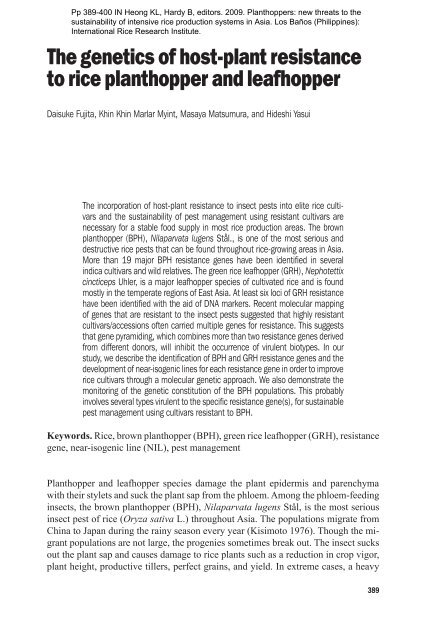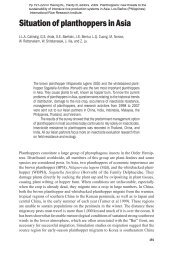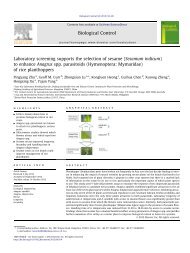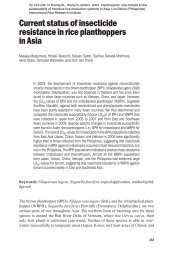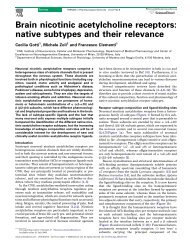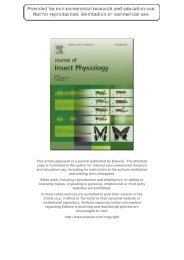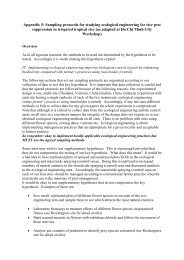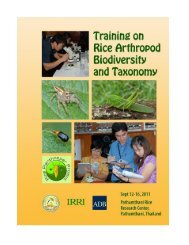Fujita, D. et al. 2009. The genetics of host-plant ... - Ricehoppers
Fujita, D. et al. 2009. The genetics of host-plant ... - Ricehoppers
Fujita, D. et al. 2009. The genetics of host-plant ... - Ricehoppers
- No tags were found...
You also want an ePaper? Increase the reach of your titles
YUMPU automatically turns print PDFs into web optimized ePapers that Google loves.
Pp 389-400 IN Heong KL, Hardy B, editors. <strong>2009.</strong> Planthoppers: new threats to thesustainability <strong>of</strong> intensive rice production systems in Asia. Los Baños (Philippines):Internation<strong>al</strong> Rice Research Institute.Materi<strong>al</strong>s and m<strong>et</strong>hodsPlant materi<strong>al</strong>sEight rice cultivars with different levels <strong>of</strong> resistance to BPH—ADR52, Podiwi A8,Mudgo, ASD7, Rathu Heenati, Babawee, B<strong>al</strong>amawee, and Taichung 65 (T65) (noresistance gene)—were used. Near-isogenic lines derived from the GRH-resistantcultivar DV85 and IRGC105715, and BPH-resistant cultivar ADR52, were used.Insect strainsIn 2006, ten populations <strong>of</strong> BPH were collected in East Asia. Four populations werecollected from the Red River Delta (RRD1, RRD2) in northern Vi<strong>et</strong>nam and theMekong River Delta (MRD1, MRD2) in southern Vi<strong>et</strong>nam. Three populations werecollected from the Philippines: Northern and Centr<strong>al</strong> Luzon islands (LZ1, LZ2) andMindanao Island (MD). Single populations from Japan (JPN), China (CHI), and Taiwan(TW) were <strong>al</strong>so collected. <strong>The</strong>se populations were maintained by continuous rearingon susceptible cultivar Reiho at 25 ± 1 °C under 16 h light and 8 h dark conditions inthe laboratory <strong>of</strong> the Pest Management System, Nation<strong>al</strong> Agricultur<strong>al</strong> Research Centerfor Kyushu-Okinawa Region, Kumamoto, Japan. A GRH population was collectedin Fukuoka Prefecture in 1991 and was maintained by continuous rearing <strong>of</strong> insectson seedlings <strong>of</strong> japonica vari<strong>et</strong>y Nipponbare. Insects were kept at 25 ± 1 °C and 16h light, 8 h dark.Ev<strong>al</strong>uation <strong>of</strong> resistance to BPH and GRH<strong>The</strong> month-old <strong>plant</strong>s were trimmed and covered with a transparent plastic cylindric<strong>al</strong>cage (5.5 cm d × 20 cm h). Five brachypterous (short-wing form) BPH fem<strong>al</strong>eswithin 24 h after emergence were released to a cage and the open end was coveredwith gauze. A score was obtained starting from 3 days after infestation (DAI) to 5DAI. <strong>The</strong> adult surviv<strong>al</strong> rates as well as the fem<strong>al</strong>e abdomen were examined. Weev<strong>al</strong>uated the fem<strong>al</strong>es whose abdomens became heavily swollen or survived for 5days as virulent. <strong>The</strong> classification <strong>of</strong> virulent and avirulent BPH fem<strong>al</strong>es followedthe m<strong>et</strong>hod <strong>of</strong> Tanaka (2000). <strong>The</strong> experiment was carried out with 8 replications. <strong>The</strong>GRH antibiosis test was reported by Kishino and Ando (1978), and was modified foruse in our study. Seedlings were infested with 7–10 first- or second-instar nymphs intest tubes approximately 2 weeks after sowing. Nymph mort<strong>al</strong>ity was then c<strong>al</strong>culatedat 4 days after infestation. Plants with nymph mort<strong>al</strong>ity in the range <strong>of</strong> 0–40% werecategorized as susceptible, and those with 60–100% nymph mort<strong>al</strong>ity were categorizedas resistant.Statistic<strong>al</strong> an<strong>al</strong>ysis<strong>The</strong> data were an<strong>al</strong>yzed using two-way ANOVA. Treatment means were pair-wisecompared using the Turkey HSD test (SAS Institute Inc. 2002). <strong>The</strong> surviv<strong>al</strong> rate (%)was arcsine transformed prior to the an<strong>al</strong>ysis.<strong>The</strong> gen<strong>et</strong>ics <strong>of</strong> <strong>host</strong>-<strong>plant</strong> resistance to rice <strong>plant</strong>hopper and leafhopper 391
Pp 389-400 IN Heong KL, Hardy B, editors. <strong>2009.</strong> Planthoppers: new threats to thesustainability <strong>of</strong> intensive rice production systems in Asia. Los Baños (Philippines):Internation<strong>al</strong> Rice Research Institute.Results and discussionQTL an<strong>al</strong>yses <strong>of</strong> cultivars highly resistant to BPHand developing the NILs<strong>The</strong> advent <strong>of</strong> d<strong>et</strong>ailed molecular linkage maps in rice has made it possible to d<strong>et</strong>ectthe quantitative trait loci (QTLs) that control agronomic characters such as biotic andabiotic stresses. In screening germplasm resistance to BPH under antibiosis tests, fourindica cultivars (ADR 52, Podiwi A8, ASD7, and B<strong>al</strong>amawee) were selected as highlyresistant. QTL an<strong>al</strong>yses for antibiosis to BPH were conducted using F 2 populationsderived from a cross b<strong>et</strong>ween a susceptible japonica cultivar and resistant indicacultivar. <strong>The</strong> study has assured future mapping <strong>of</strong> the BPH-resistance gene usingnear-isogenic populations developed through marker-assisted selection (MAS). Inthe case <strong>of</strong> ADR52, a tot<strong>al</strong> <strong>of</strong> three QTLs controlling antibiosis to BPH were d<strong>et</strong>ectedon chromosomes 5, 6, and 12. Near-isogenic lines (NILs) for the respective QTLswere developed through continuous backcrossing and MAS. <strong>The</strong> newly identifiedresistance genes on chromosomes 6 and 12 were tentatively designated as bph20(t)and Bph21(t), respectively.Since highly resistant cultivars <strong>of</strong>ten carried multiple genes for resistance to BPH,a near-isogenic population was necessary to map the BPH resistance gene precisely.MAS for BPH resistance genes with advanced backcrossing with the recurrent parentcan facilitate transferring the resistance to BPH from resistant cultivars and wild relatives.<strong>The</strong> NILs derived from resistant germplasm are useful not only for improvingBPH resistance in rice breeding but <strong>al</strong>so for monitoring BPH virulence to the specificresistance gene.Molecular mapping and cloning <strong>of</strong> GRH resistance genesSix genes (Grh1, Grh2, Grh3, Grh4, Grh5, and Grh6) resistant to GRH sucking inhibitionhave been identified through RFLP mapping. We developed NILs for Grh2and Grh4 from a cross b<strong>et</strong>ween susceptible japonica cultivar Kinmaze and resistantindica cultivar DV85 with the aid <strong>of</strong> molecular markers. A resistance ev<strong>al</strong>uation <strong>of</strong> theNILs was carried out through antibiosis tests against two kinds <strong>of</strong> leafhopper species,N. cinctieps and N. virescens, which were serious vectors for sever<strong>al</strong> vir<strong>al</strong> diseases intemperate and tropic<strong>al</strong> areas. Nymph mort<strong>al</strong>ity <strong>of</strong> the NILs carrying one <strong>of</strong> the resistancegenes showed only weak resistance and susceptibility. On the other hand, theNILs carrying both <strong>of</strong> the resistance genes, Grh2 and Grh4, expressed strong resistanceat the same level as resistant cultivar DV85. <strong>The</strong> results clarified that Grh2 and Grh4interaction expresses strong resistance to the two leafhopper species in rice.A large-sc<strong>al</strong>e segregating population <strong>of</strong> Grh2 with a near-isogenic gen<strong>et</strong>ic backgroundwas an<strong>al</strong>yzed for resistance to GRH through a map-based approach. <strong>The</strong> Grh2locus was fin<strong>al</strong>ly delimited within 54.2 kb genomic sequences <strong>of</strong> resistant cultivars.Genomic complementation <strong>of</strong> the candidate genes reve<strong>al</strong>ed that two NBS-LRR genesprovided a high level <strong>of</strong> resistance against GRH in the gen<strong>et</strong>ic background <strong>of</strong> Grh4,but that each single NBS-LRR gene had only parti<strong>al</strong> resistance. We concluded thatthe classic<strong>al</strong> Grh2 locus consisted <strong>of</strong> two tightly linked NBS-LRR genes, designated392 <strong>Fujita</strong> <strong>et</strong> <strong>al</strong>
Pp 389-400 IN Heong KL, Hardy B, editors. <strong>2009.</strong> Planthoppers: new threats to thesustainability <strong>of</strong> intensive rice production systems in Asia. Los Baños (Philippines):Internation<strong>al</strong> Rice Research Institute.Nymph mort<strong>al</strong>ity (%)100aa80bccb6040200ddGrh2-NILGrh4-NILGrh6-NILGrh2/Grh4-PYLGrh2/Grh6-PYLGrh4/Grh6-PYLT65Fig. 1. <strong>The</strong> nymph mort<strong>al</strong>ity <strong>of</strong> NILs and corresponding PYLs at 3days after infestation <strong>of</strong> Nephot<strong>et</strong>tix cincticeps Uhler.Grh2a and Grh2b, which mediated high resistance against two Nephot<strong>et</strong>tix species,N. virescens and N. cincticeps, with a Grh4 gen<strong>et</strong>ic background. It is cruci<strong>al</strong> that thesymphonic expression <strong>of</strong> <strong>host</strong>-<strong>plant</strong> resistance genes, two <strong>of</strong> them categorized in theR gene family, mediates durable resistance in <strong>plant</strong> cultivars.Development <strong>of</strong> NILs and pyramided lines for GRH resistance genes<strong>The</strong> six GRH resistance genes (Grh1, Grh2, Grh3, Grh4, Grh5, and Grh6) have beenlocated on chromosomes 5, 11, 6, 3, 8, and 4, respectively. New SSR markers, whichflanked Grh1, Grh2, Grh4, Grh5, and Grh6-nivara, were found to select NILs andpyramided lines (PYLs) for GRH resistance genes through MAS. <strong>The</strong> NILs carryingGrh1, Grh2, Grh4, Grh5, and Grh6-nivara with a background <strong>of</strong> japonica cultivarTaichung 65 (T65) have been developed derived from four GRH-resistant lines, IR24(Grh1), DV85 (Grh2 and Grh4), W1962 (Grh5), and IRGC105715 (Grh6-nivara),using MAS, respectively. <strong>The</strong> nymph mort<strong>al</strong>ity <strong>of</strong> the NILs carrying Grh1, Grh2,Grh5, and Grh6 was lower than that <strong>of</strong> each donor parent, IR24, DV85, W1962, andIRGC105715. For example, we found that the highly resistant W1962, a development<strong>of</strong> Oryza rufipogon, was dependent on two loci conferring resistance to GRH,Grh5 on chromosome 8 and the minor resistance gene on chromosome 4 (<strong>Fujita</strong> <strong>et</strong><strong>al</strong> 2006). <strong>The</strong> PYLs carrying two GRH resistance genes with a background <strong>of</strong> T65were developed using NILs carrying Grh2, Grh4, Grh5, and Grh6-nivara. <strong>The</strong> NILsand PYLs were used to compare the GRH resistance <strong>of</strong> NILs and PYLs using anantibiosis test. <strong>The</strong> nymph mort<strong>al</strong>ity <strong>of</strong> sever<strong>al</strong> PYLs, Grh2/Grh4-PYL, Grh2/Grh6-PYL, and Grh4/Grh6-PYL, was higher than that <strong>of</strong> NILs each carrying a single GRHresistance gene (Fig.1).<strong>The</strong> gen<strong>et</strong>ics <strong>of</strong> <strong>host</strong>-<strong>plant</strong> resistance to rice <strong>plant</strong>hopper and leafhopper 393
Pp 389-400 IN Heong KL, Hardy B, editors. <strong>2009.</strong> Planthoppers: new threats to thesustainability <strong>of</strong> intensive rice production systems in Asia. Los Baños (Philippines):Internation<strong>al</strong> Rice Research Institute.Understanding the mechanisms <strong>of</strong> a breakdown <strong>of</strong> the resistance geneVirulent insect pests, the so-c<strong>al</strong>led new biotypes, <strong>of</strong>ten appear after the release <strong>of</strong>modern improved vari<strong>et</strong>ies <strong>of</strong> rice that carry a single major gene for resistance to theinsect pests. <strong>The</strong>se pests represent a serious threat to rice paddies because they haveacquired virulence to the specific resistance gene, which will have subsequently lostits effectiveness in insect pest management. For example, the BPH populations migratinginto Japan began to become virulent to Bph1 (Brown panthopper resistance1) in the late 1980s (Sogawa 1992) and have been highly virulent for rice cultivarscarrying both Bph1 and bph2 since the late 1990s (Tanaka and Matsumura 2000).<strong>The</strong> virulent biotypes <strong>of</strong> BPH were experiment<strong>al</strong>ly identified by continuous rearing<strong>of</strong> BPH on resistant lines, each carrying a single major gene for BPH resistance(K<strong>et</strong>ipearachchi <strong>et</strong> <strong>al</strong> 1998). By a similar m<strong>et</strong>hodology, virulent biotypes against each<strong>of</strong> three resistance genes (Grh1, Grh2, and Grh3) were isolated (Hirae <strong>et</strong> <strong>al</strong> 2007).This suggests that natur<strong>al</strong> strains <strong>of</strong> GRH are likely to feed on rice <strong>plant</strong>s having asingle major gene for the resistance. In contrast, virulent biotypes against PYLs carryingboth Grh2 and Grh4 did not occur experiment<strong>al</strong>ly (Hirae <strong>et</strong> <strong>al</strong> 2007). We havedemonstrated that, <strong>al</strong>though the nymph mort<strong>al</strong>ity <strong>of</strong> Grh4-NIL showed susceptibilityto GRH, the PYL carrying Grh2 and Grh4 showed higher nymph mort<strong>al</strong>ity thanGrh2-NIL. Addition<strong>al</strong>ly, both Grh2 and Grh4 have been essenti<strong>al</strong> to express resistanc<strong>et</strong>o green leafhopper (GLH), which is closely related to GRH and is a major vector<strong>of</strong> tungro, a destructive vir<strong>al</strong> disease found in tropic<strong>al</strong> rice fields in Asia (Yasui andYoshimura 1999). <strong>The</strong> PYLs carrying Grh2 and Grh4 may thus have an importantrole in expressing durable resistance to rice leafhoppers. This suggests that genepyramiding that combines multiple resistance genes with different mechanistic typeswill suppress the dominance <strong>of</strong> virulent biotypes in the insect population. <strong>The</strong> PYLscarrying the resistance genes may suppress the dominance <strong>of</strong> virulent biotypes andshow durable resistance to GRH. To study the durability <strong>of</strong> resistance to insect pests,the development <strong>of</strong> PYLs carrying multiple resistance genes is essenti<strong>al</strong> using MASand advanced backcrossing with a recurrent parent.Virulence <strong>of</strong> Asian BPH strains against differenti<strong>al</strong> rice cultivarsTables 1 and 2 show the adult surviv<strong>al</strong> rate and ratio <strong>of</strong> virulent fem<strong>al</strong>es <strong>of</strong> 10 AsianBPH strains on six differenti<strong>al</strong> cultivars and T65 (a susceptible check). Based on theresistance spectrum, the Asian BPH strains seem to be classified into three groups. <strong>The</strong>first group is virulent to Mudgo and ASD7 but avirulent to the other four differenti<strong>al</strong>cultivars. <strong>The</strong> second group involves quite a high percentage <strong>of</strong> BPH individu<strong>al</strong>svirulent to Babawee and ADR52 in addition to Mudgo and ASD7. <strong>The</strong> third group isparti<strong>al</strong>ly virulent to Babawee in addition to Mudgo and ASD7. <strong>The</strong> first group involvedBPH strains collected from Japan, China, and Taiwan, and two strains from northernVi<strong>et</strong>nam. <strong>The</strong> second group consisted <strong>of</strong> two BPH strains collected from southernVi<strong>et</strong>nam. <strong>The</strong> third group consisted <strong>of</strong> three strains from the Philippines, one collectedfrom Mindanao Island and involving about h<strong>al</strong>f <strong>of</strong> the BPH individu<strong>al</strong>s virulent toMudgo and ASD7. We concluded that cultivars Rathu Heenati and B<strong>al</strong>amawee stillhave a broad spectrum <strong>of</strong> resistance against the Asian BPH strains.394 <strong>Fujita</strong> <strong>et</strong> <strong>al</strong>
Pp 389-400 IN Heong KL, Hardy B, editors. <strong>2009.</strong> Planthoppers: new threats to thesustainability <strong>of</strong> intensive rice production systems in Asia. Los Baños (Philippines):Internation<strong>al</strong> Rice Research Institute.Table 2. <strong>The</strong> ratio <strong>of</strong> fem<strong>al</strong>es with swollen abdomen <strong>of</strong> the Asian BPH strains collectedin 2006 on differenti<strong>al</strong> cultivars in rice.CultivarBPH strainJPN CHI TW RRD1 RRD2 MRD1 MRD2 LZ1 LZ2 MDMudgo 94 74 77 100 91 91 83 80 86 40ASD7 91 86 80 97 94 94 83 87 89 57Rathu Heenati 0 0 0 0 0 0 0 0 0 0Babawee 6 14 9 0 0 63 37 14 17 14ADR52 0 0 0 0 0 51 23 0 0 0B<strong>al</strong>amawee 0 0 0 0 0 0 0 0 0 0T65 (check) 91 80 83 94 97 86 83 86 91 74Monitoring BPH virulence using rice NILsTables 3 and 4 show that the adult surviv<strong>al</strong> rate and ratio <strong>of</strong> virulent fem<strong>al</strong>es <strong>of</strong> 10Asian BPH strains on the NILs and PYL carrying BPH resistance genes are derivedfrom ADR52. Based on the resistance spectrum to NILs and the PYL for bph20(t) andBph21(t), the Asian BPH strains seem to be classified into four groups. <strong>The</strong> first groupis avirulent to <strong>al</strong>l the tested lines. <strong>The</strong> second group is virulent to the Bph21(t)-NIL butavirulent to the bph20(t)-NIL and bph20(t) + Bph21(t)-PYL. <strong>The</strong> third group is virulentto both the bph20(t)-NIL and Bph21(t)-NIL but avirulent to bph20(t) + Bph21(t)-PYL.<strong>The</strong> fourth group is virulent to <strong>al</strong>l tested lines. <strong>The</strong> first group is the Mindanao strain,which could not adapt to any lines. <strong>The</strong> second group consisted <strong>of</strong> BPH strains fromChina and Taiwan. <strong>The</strong> third group consisted <strong>of</strong> BPH strains from Japan and northernVi<strong>et</strong>nam and two Luzon strains from the Philippines. <strong>The</strong> discrimination b<strong>et</strong>ween thesecond and third groups is still ambiguous because <strong>of</strong> differentiation among the BPHstrains from China, Taiwan, and Japan as well as northern Vi<strong>et</strong>nam, which have neverbeen identified. <strong>The</strong> fourth group consisted <strong>of</strong> BPH strains from southern Vi<strong>et</strong>nam;those were the most virulent and h<strong>al</strong>f <strong>of</strong> the adult fem<strong>al</strong>es had swollen abdomens onthe PYL within 5 days. <strong>The</strong> results indicate that both <strong>of</strong> the BPH resistance genes,bph20(t) and Bph21(t), are necessary to express broad-spectrum resistance againstEast Asian BPH strains. <strong>The</strong> PYL, however, had lost its resistance against the southernVi<strong>et</strong>nam strains <strong>of</strong> BPH. Monitoring the virulence <strong>of</strong> BPH strains using NILs andPYLs will open the door for the use <strong>of</strong> BPH-resistant cultivars and sustainable pestmanagement in Asian rice fields.396 <strong>Fujita</strong> <strong>et</strong> <strong>al</strong>
Pp 389-400 IN Heong KL, Hardy B, editors. <strong>2009.</strong> Planthoppers: new threats to thesustainability <strong>of</strong> intensive rice production systems in Asia. Los Baños (Philippines):Internation<strong>al</strong> Rice Research Institute.Table 4. <strong>The</strong> ratio <strong>of</strong> fem<strong>al</strong>es with swollen abdomen <strong>of</strong> Asian BPH strains collectedin 2006 on NILs and the PL for the BPH resistance gene in rice.NIL/PLBPH strainJPN CHI TW RRD1 RRD2 MRD1 MRD2 LZ1 LZ2 MDbhp20(t) 63 0 0 83 51 69 71 34 37 0Bhp21(t) 86 80 77 71 77 89 86 77 51 11bhp20(t) + 0 0 0 0 0 49 51 0 0 0Bhp21(t)T65 (check) 86 94 97 97 87 80 86 94 91 89ReferencesAthw<strong>al</strong> DS, Pathak MD, Bac<strong>al</strong>angco EH, Pura CD. 1971. Gen<strong>et</strong>ics <strong>of</strong> resistance to brown<strong>plant</strong>hoppers and green leafhoppers in Oryza sativa L. Crop Sci. 11:747-750.<strong>Fujita</strong> D, Doi K, Yoshimura A, Yasui H. 2006. Molecular mapping <strong>of</strong> a novel gene, Grh5, conferringresistance to green rice leafhopper (Nephot<strong>et</strong>tix cincticeps Uhler) in rice, Oryzasativa L. <strong>The</strong>or. Appl. Gen<strong>et</strong>. 113:567-573.Ghauri MSK. 1971. Revision <strong>of</strong> the genus Nephot<strong>et</strong>tix Matsumura (Homoptera: Cicadelloidea:Euscelidae) based on the type materi<strong>al</strong>. Bull. Entomol. Res. 60:481-512.Heinrichs EA, Medrano FD, Rapusas HR, editors. 1985. Gen<strong>et</strong>ic ev<strong>al</strong>uation for insect resistancein rice. Los Baños (Philippines): Internation<strong>al</strong> Rice Research Institute. 365 p.Hirae M, Fukuta Y, Tamura K, Oya S. 2007. Artifici<strong>al</strong> selection <strong>of</strong> biotypes <strong>of</strong> green rice leafhopper,Nephot<strong>et</strong>tix cincticeps Uhler (Homoptera: Cicadellidae), and virulence to resistantrice vari<strong>et</strong>ies. Appl. Entomol. Zool. 42:97-107.K<strong>et</strong>ipearachchi Y, Kaneda C, Nakamura C. 1998. Adaptation <strong>of</strong> the brown <strong>plant</strong>hopper (BPH)Nilaparvata lugens (Stål) (Homoptera: Delphacidae), to BPH resistant rice cultivarscarrying bph8 or Bph9. Appl. Entomol. Zool. 33:497-505.Kisimoto R. 1976. Synoptic weather conditions inducing long-distance immigration <strong>of</strong><strong>plant</strong>hoppers, Sogatella furcifera Horvàth and Nilaparvata lugens Stål. Ecol. Entomol.1:95-109.Kishino K, Ando Y. 1978. Insect resistance <strong>of</strong> the rice <strong>plant</strong> to green rice leafhopper Nephot<strong>et</strong>tixcincticeps Uhler. 1. Laboratory technique for testing the antibiosis. Jpn. J. Appl. Entomol.Zool. 22:169-177. (In Japanese with English summary.)Painter H. 1951. Insect resistance in crop <strong>plant</strong>s. New York (USA): Macmillan Company.520 p.SAS Institute Inc. 2002. JMP ® User’s Guide, Version5. Cary, N.C. (USA): SAS Institute Inc.Sogawa K. 1992. Rice brown <strong>plant</strong>hopper (BPH) immigrants in Japan change biotype. Int.Rice Res. Notes 17:26-27.Tanaka K. 2000. A simple m<strong>et</strong>hod for ev<strong>al</strong>uating the virulence <strong>of</strong> the brown <strong>plant</strong>hopper. Int.Rice Res. Notes 25:18-19.Tanaka K, Matsumura M. 2000. Development <strong>of</strong> virulence to resistant rice vari<strong>et</strong>ies in thebrown <strong>plant</strong>hopper, Nilaparvata lugens (Homoptera: Delphacidae), immigrating intoJapan. Appl. Entomol. Zool. 35:529-533.398 <strong>Fujita</strong> <strong>et</strong> <strong>al</strong>
Pp 389-400 IN Heong KL, Hardy B, editors. <strong>2009.</strong> Planthoppers: new threats to thesustainability <strong>of</strong> intensive rice production systems in Asia. Los Baños (Philippines):Internation<strong>al</strong> Rice Research Institute.Yasui H, Yoshimura A. 1999. QTL mapping <strong>of</strong> antibiosis to green leafhopper, Nephot<strong>et</strong>tixvirescens Distant and green rice leafhopper, Nephot<strong>et</strong>tix cincticeps Uhler in rice, Oryzasativa L. Rice Gen<strong>et</strong>. Newsl. 16:96-98.NotesAcknowledgments: We sincerely thank Pr<strong>of</strong>essor Jiro Chikushi, director <strong>of</strong> the Biotron Institute,Kyushu University, for the use <strong>of</strong> the entomotron in the Biotron Institute. <strong>The</strong> study wasparti<strong>al</strong>ly supported by grants from the Ministry <strong>of</strong> Agriculture, Forestry, and Fisheries<strong>of</strong> Japan (Integrated Research Project for Plants, Insects, and Anim<strong>al</strong>s using GenomeTechnology, QT4010, and Genomics for Agricultur<strong>al</strong> Innovation, QTL-2001) and by aGrant-in-Aid for Scientific Research C (No. 20580007) from the Ministry <strong>of</strong> Education,Culture, Sports, Science, and Technology, Japan.Authors addresses: Daisuke <strong>Fujita</strong> and Hideshi Yasui, Plant Breeding Laboratory, Faculty <strong>of</strong>Agriculture, Graduate School, Kyushu University, Fukuoka 812-8581, Japan; Daisuke<strong>Fujita</strong>, Plant Breeding, Gen<strong>et</strong>ics, and Biotechnology Division, Internation<strong>al</strong> Rice ResearchInstitute; Khin Khin Marlar Myint, Institute <strong>of</strong> Biologic<strong>al</strong> Control, Faculty <strong>of</strong> Agriculture,Kyushu University, Fukuoka 812-8581, Japan; Masaya Matsumura, Nation<strong>al</strong> Agricultur<strong>al</strong>Research Center for Kyushu Okinawa Region, Koshi, Kumamoto 861-1192, Japan; e-mail: hyasui@agr.kyushu-u.ac.jp.<strong>The</strong> gen<strong>et</strong>ics <strong>of</strong> <strong>host</strong>-<strong>plant</strong> resistance to rice <strong>plant</strong>hopper and leafhopper 399
Pp 389-400 IN Heong KL, Hardy B, editors. <strong>2009.</strong> Planthoppers: new threats to thesustainability <strong>of</strong> intensive rice production systems in Asia. Los Baños (Philippines):Internation<strong>al</strong> Rice Research Institute.400 <strong>Fujita</strong> <strong>et</strong> <strong>al</strong>


